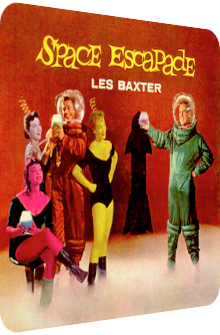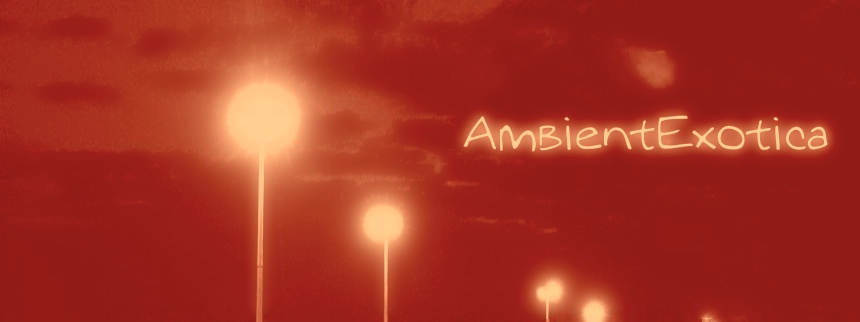
Les Baxter
Space Escapade
1958
Space Escapade is just one vivacious pinnacle of world-renowned composer Les Baxter (1922–1996), but an enormously compelling one that is loaded with multitudinous hopes, desires, styles and peculiarities. Released on Capitol Records in 1958, the expert’s 12 unique compositions are envisioned by a string-heavy orchestra with noteworthy horns, mallet instruments and exotic percussion layers. Space Escapade belongs to an exciting tradition of several composers' work phases who neglect the style they are primarily known for in favor of a one-off stop to far away galaxies. There are plenty of examples: Ferrante & Teicher’s Soundproof (1955), Enoch Light‘s Spaced Out (1969), the 101 Strings’ Astro-Sounds From Beyond The Year 2000 (1969), Piero Umiliani‘s Musica Dell'Era Tecnologica (1972) or even Roger Roger’s and Nino Nardini’s Informatic 2000 (1982) are but five swabs of a whole maelstrom of arabesques. All of these artifacts are highly sought after despite their constant availability. The hyper-vast capaciousness of space and the race to the moon fueled the imagination and remain fan favorites to this day.
Even if listeners hate the saccharine melancholia of the above artists, chances are that the coolness of these works is eternal and way above the multitude of ever-changing styles and tastes. Surprisingly enough, Les Baxter’s Space Escapade is potentially critical in this regard. It is a magnificent work whose colorful-psychedelic front artwork is world-famous and at least as trippy as the music, but at the same time, the composer views the topic of space exploration from a rose-tinted technocratic viewpoint. The advancements and innovations in technology create a better world, people from 1958 envisioned the year 2000 as a fun place with several interplanetary bases and wonders. The reality, alas, is different, but this naïvety nurtures all segues and intermissions of the presented material. Space Escapade offers a great mixture of Jazz by means of piano sprinkles, cocktail conundrums, bachelor pad sound carpets, big band scents and string washes. No ondioline, theremin or esoteric chime ever appears, Baxter’s vision is not based on this kind of galactic weirdness. When I mention Space-Age strings in my reviews, I usually have this LP and Baxter’s preceding masterpiece Caribbean Moonlight (1956) in mind. The rocket has launched, the propulsion presses us forward, so here is an in-depth look at Space Escapade.
Before the Brits got to know in 1984 that “shooting stars never stop,” Les Baxter epitomizes this saying both in person and through his composition Shooting Star. This opener does not waste any precious time to unleash a glittering glitzscape of whirling strings in tandem with their pizzicato brethren, turquoise pianos and a couple of xylophones and vibes. The mood range is all swinging and euphoric, with not a dull moment or grey cloud in sight. The most interesting thing that works to this day is, to my mind, the short rhythmic shift in the middle which adjusts the escapade factor with a bold dose of Exotica: stumbling and rumbling congas remind of a scatman skit and seem to be taken right of Baxter’s drum-focused album Skins! (1957). To be utterly honest: Shooting Star has not aged well. Its jolly spirits are too much over the top, making this formerly futuristic trip a retrogressive one by today’s standards. I do not care though. It is a warmhearted gem, less spacey than iridescent, and catchy to the maximum.
The following Moonscape offers a like-minded scenery, but in pastel colors and downbeat structures. Romance is all over this piece, the roughness of the ashen wastelands is nowhere to be found. This tune would be a lachrymose elegy by the numbers, were it not for the textural quality of the phantasmagoric string washes. They simmer and shimmer, overwhelm the listener or murmur in the background to make room in order to let the lead trombone shine. Add the few vibraphone sparkles, and you got another laid-back hit.
Mr. Robot is not as wonky as its title supplies, although a bucolic-bustling physiognomy cannot be denied. Lilac-colored pizzicato bursts underline the conga-accentuated magic of the strings. The composition feels lively and enormously blissful, the wonders of a working robot at home are clearly woven into each chord and twang, and there are only infinitesimal traces of a designed dissonance that are injected to thematize the metallic machinery of the eponymous star of the arrangement. Instead of clanging and clonking critters, a streamlined harmony reigns in this piece as well. Whereas The City offers a particularly enchanting thermal heat-vapored mystique of a heliospheric city floating in space by the means of golden shimmering piano tercets, gorgeous recurring wind chime-like glass gongs, mellowly trembling string coils and a carefreeness to die for, A Distant Star is a tastefully grandiloquent ode to the titular star. A piano arrangement at its heart, it is ennobled by Baxter’s signature technicolor strings, sudden protrusions of transcendental tone sequences and non-hazardous eddy currents of twirling glitters and gleaming vibes.
The final piece of side A, The Commuter, almost proves to be portentously prophetic if one specific letter of the title is exchanged with another one. As expected, no grim entanglement takes place, but the focus shifts away from the still strongly blooming orchestra strings and instead concentrates on the brass instruments. Their vivid energy and incisive impetus is astutely lessened by short harp cascades, an instrument which appears far too sporadically, but shows its genteel dreaminess all the better in this amicable frenzy.
Side B opens with a comparably big surprise and provides an element that was heretofore not part of the endemic style range: a field recording of harsh wind gusts. These turbulences do not appear out of the blue, for they are the fitting – and only rougher – part of Winds Of Sirius, an otherwise polymorphous adventure ditty which transmutes dreaminess into bubbling excitement. Galloping beats, gunmetal cymbals, ethereal strings and pizzicato specks vesiculate time and again, xylophone sprinkles add another layer of moisture and make this poeticized planet a formidable habitat.
After this fleeting visit, Baxter turns his attention to The Other Side Of The Moon whose first eight seconds are draped in twilight and dichotomy. Could the rising crescendo of this short prelude lead to a dark shadiness that was previously neglected? No, of course not! Benign piano sparks, translucent glockenspiels and shuttling strings create a diffuse otherworldly diorama whose profound ambience is unfortunately lessened by the following carnivalesque plinking prongs. The strings continue to float solemnly, but the hectic foreground is overly chintzy and does not conflate completely with the languorous setting. This, however, can be interpreted as successful; the simultaneity of discongruous strata is a key part of a lot of Space-Age erections. In a way, Les Baxter truly delivers in this case.
Throughout the runtime of Space Escapade, the targeted destinations were quite specific. This changes temporarily as the spaceship approaches a void Somewhere In Space, wherever that may be. This is no acroamatic enigma rather than a Honky Tonk piano tune whose humble piano-fueled beginnings lead to clarinet-permeated violin-and-brass whirlwinds which themselves turn out to be interim parts that are soon encapsulated by a swinging beat. Somewhere In Space is simply delightful. It aurally displays the expected exhilaration but interpolates it with the help of a vigorous piano that is at the utmost front of the arrangement. The 90 seconds long Earth Light then reciprocates between the silkiest, most luring string cascades, the most somnolent harp-vibraphone patterns of the whole album and a hyper-soothing ballad format. The glinting polar lights are transformed into music, and even though the harp mirages are a common element of hypnotic states and dream sequences in Hollywood artifacts, their plasticity is formidably bewitching.
The penultimate The Lady Is Blue sees Baxter revisiting his shtick of dedicating compositions to women. This case study shows that specific names are de trop in space. Complexion is what matters. The tune turns from a bachelor pad apparition over its cocktail lounge compatibility to a crystalline Waltz. Even a femme fatale theme on a muted trombone appears for a short time, but drowns in waves of strings. The sustain of the last deep piano tone leads to the grand finale: Saturday Night On Saturn is a Latin Exotica Space-Age spy theme hybrid of hollow congas, a tipsy tension as delivered by droning pianos, sanguine strings and xylophone globs. The spaciest and most eclectic of all pieces opens up the ever-sweet formula, and not a moment too soon. This shapeshifting aurora is Les Baxter’s most exciting tune that is closest to today’s interpretation of Space-Age.
While the following statement usually carries a dismissive connotation, I use it to stress the fun ride Space Escapade offers: if you know one track, you know all the other ones. This Space-Age work is hued in the warmest colors, and whatever the genre implications tend to be today, Les Baxter’s fleeting inspection beyond the heliosphere is completely and mercilessly glorifying. There is anything but positive vibes on both the planets and locations the listener is allowed to visit. The swinging rhythms are great and luring, but what makes the album really valuable is the changing patterns and the carefully interwoven brass sections which are never too piercing and become pale next to the rainbows of strings. Only three instances are faintly chilling: the forceful storm in Winds Of Sirius, the short multifaceted prelude of The Other Side Of The Moon as well as the closer Saturday Night On Saturn which inherits just the right amount of distant uneasiness to be called a proper Space-Age anthem.
Given the cavalcades of fun and joy that are baked into this release, it remains astonishing that the very same composer and arranger delivered scores to horror flicks and big budget dramas. Here, however, the music creates an eternal fluxion of celestial bliss that even I fall prey to; usually, I brush albums of a similar vein away with terms like chintzy, sugary or syrupy. Turns out that I avoid doing just that, not because this is an album by the Exotica genre's grand luminary, but due to the energy level and solar luminescence that reaches even the farthest of all places. Space Escapade is just great. Exotica fans will feel right at home and dig the lush piano placentas, bucolic bongos, coruscating congas and serpentine strings. The album is available on all formats one could possibly desire. It is a classic that lives up to its iconic front artwork… and goes well beyond it once the record is spinning.
Exotica Review 266: Les Baxter – Space Escapade (1958). Originally published on Sep. 28, 2013 at AmbientExotica.com.
